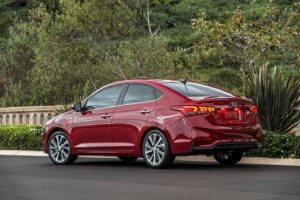By Shari Prymak
Subcompact cars have come a long way over the past few decades. It doesn’t seem that long ago when most were largely considered dreary little penalty boxes often relegated to those without the means who desperately wanted a new car. Fortunately, the days when little economy cars come bare-bone to the point where air-conditioning is considered a “luxury feature” are coming to an end. And we have cars like the Hyundai Accent to thank for that.
There’s nothing particularly eye-catching about the Accent, which is fine, because attracting attention is hardly its mission. The styling is clean and inoffensive with design elements shared with its larger Elantra sibling. The interior is simple and straightforward with easy to use controls for just about anyone. The materials are far from upscale, but still totally acceptable. Everything here has a certain sense of durability to it with quality fit and construction. Spaciousness for both front and rear seat occupants is respectable, but there are more spacious options in this class. My test car was the sedan version. A more practical and versatile hatchback body style is available as well.

The only engine choice here is a 1.6L 4-cylinder producing 130 horsepower and 119 lb-ft of torque. It’s reasonably refined and gets the job done without sounding too crude when it’s being pushed. A 6-speed manual gearbox comes standard, however, most models will be equipped with the optional 6-speed automatic tested here. Even though I don’t have any issues with the CVTs that are increasingly finding their way into vehicles of this type, it’s refreshing to drive a car with a well-proven traditional transmission. Fuel economy for the week came to 7.5L/100km with a slant towards highway driving, which is on par for the class.
Driving the Accent isn’t a particularly thrilling experience, but there’s nothing offensive about it either. Whether commuting in stop-and-go city traffic or cruising down the highway, the Accent displays excellent road manners with a fairly quiet cabin and a composed ride. Like many subcompacts of this type, the Accent has a certain agility and level of maneuverability that adds to its ease of use around town. Ride quality is decent, however, my tester did come equipped with largish 17 inch wheels with somewhat stiff low profile tires. Opting for smaller wheels with thicker profile tires may lead to some improvement here.

The Accent offers a lengthy list of features throughout each trim level. The top-trim GLS model comes equipped with heated seats and steering wheel, a sunroof, and a 7 inch touchscreen with Android Auto and Apple Carplay compatibility. Hyundai’s touchscreen interface is one of the best out there with well-designed menus and quick responsiveness. The ability to rewind satellite radio pre-sets is especially clever and useful. Active safety features such as forward collision warning with automatic emergency braking are on offer as well. Base model features include Bluetooth, USB connectivity, and a backup camera.
Accent pricing begins at $14,599 and climbs up to $21,099. Hyundai is well-known to offer strong sales incentives, which is a boon for budget-conscious buyers. The top end pricing is notably less than that of competitors such as the Honda Fit and Kia Rio. This can partially be explained by the absence of options such as navigation, leather seats, or lane departure warning. In any case, looking at the less expensive trim levels that really matter to subcompact buyers, the Accent offers the right value along with a strong warranty and reputation for reliability, all of which make it a solid option.

